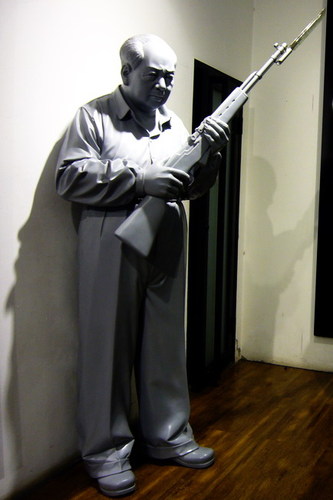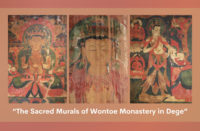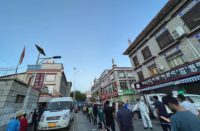High Peaks Pure Earth has translated a blogpost by Woeser written on April 28, 2012 for the Tibetan service of Radio Free Asia and posted on her blog on August 26, 2012.
As the first day of the 18th National Congress comes to a close in Beijing, this article gives insight into the structures that hold the CCP together. This is the fourth in a series by Woeser to focus on this topic; Woeser’s first article was “The ‘Mechanization’ of Party Power”, the second was “The Indistinguishable N Sequence” and the third was “The Essence of Assigning Positions in the CCP”. All of these articles have been heavily influenced by the ideas of Wang Lixiong. In the New York Times this week, Wang Lixiong writes more personally about how the National Congress has personally affected him, Woeser and Uighurs.
A piece by the Chinese artists the Gao Brothers
“The Democratic Character of Officialdom”
By Woeser
After researching the 2008 protests in Tibet, Wang Lixiong proposed the notion of “the democratic character of officialdom” and regarded this as the foundation of “the mechanisation of power”.
Since an autocratic power can only be implemented through a system of bureaucrats, if something is damaging the interests of the bureaucrats, by means of delay and distortion as well as by leaving matters unsettled and unfinished, the bureaucrats will erode the policies implemented at the higher level, making it impossible to carry out any real political tasks; Wang Lixiong calls this bottom-up resistance in an autocratic system “the democratic character of officialdom”.
No matter whether we look at an autocratic government during an ancient dynasty or one in modern times, “the democratic character of officialdom” has always widely existed; it is not embodied in the system or the procedures themselves, it manifests itself through unwritten laws, and relies even more on tacit agreements or the evolution of natural selection. When bureaucrats encounter disagreements regarding some very specific problems, they always combine and unite into factions. They are adept at scheming, at pooling together their interests and at using the existent bureaucratic system of connections to conspire and form protective networks. If an autocratic power wants to be put into practice, it needs to comply with the “democratic character of officialdom”, it needs to work towards (or at least not against) the advantage of the bureaucrats, only then can it become a practical and effective tool and not an opponent that presents outward unity but suffers from internal opposition.
Even the mighty Mao Zedong, when he wanted to initiate a movement affecting officialdom, was unable to publish an article in Beijing. Mao eventually launched the Cultural Revolution as a means to overcome officialdom, directly calling the labouring masses to revolt and destroy the ruling bureaucrats from below. However, Mao still could not leave the group of bureaucrats, after removing the old officials, new ones evolved as the interest group in exactly the same manner, the “democratic character of officialdom” continued to function. After Mao died, when his body had barely become cold, his wife was put in prison, the powerful bureaucrats eliminated everything they could and the “factions that embarked on the path of capitalism” that Mao had overthrown had fully recovered again.
Deng Xiaoping who had suffered from the Cultural Revolution decided to establish restrictions and conditions directed at leaders inside the Party and for that he drew on precisely this notion of “the democratic character of officialdom” – also called “inner party democracy”. In today’s CCP, inner party conflicts are weaker than they have ever been before, the transferral of power also happens according to procedures. A leader can no longer become a dictator placed above the group of bureaucrats, only if he tries everything to benefit the interests of the bureaucrats, can he rest assured that his position is stable. It is, of course, obvious that this kind of “inner party democracy” has nothing in common with Chinese democracy or people’s democracy.
If one understands this “democratic character of officialdom”, one also understands why Chinese policies towards Tibet are not changing. More than ten different departments at provincial and national level dealing with Tibetan issues are involved, plus an even greater number of “anti-secession” departments. Those who understand China all know that the central government is often helpless if even only one unit of a provincial or national department does not implement the central policies, imagine if over ten departments unite together to erode the central policies.
After the 2008 incident in Tibet, there were no movements at the upper levels of the CPP, most issues were left to the “anti-secession” departments to deal with, which is a significant characteristic of that incident. The “anti-secession” departments covered many different aspects of power, they had authority over the official seal, over weapons and armed forces, over the written word; they strategically cooperated with each other and established a complete chain of decision-making, implementation and completion; even in the absence of any senior leader, they managed to coordinate and operate on their own.
Thus, Wang Lixiong believes that attempts such as the international community urging the Chinese leadership to meet with the Dalai Lama, or the Dalai Lama hoping to bypass the middlemen and directly engage in a dialogue with the higher officials, or the Tibetan elite writing letters of persuasion to high officials, all do not really identify the real determining element. How to solve the Tibetan problem is already nothing that Chinese leaders can simply decide upon themselves. Hoping that a CCP leader alone can solve the Tibetan problem is nothing but an unrealistic fantasy.
April 28, 2012






Follow Us!